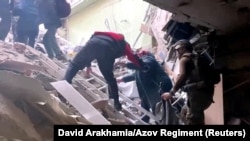On May 1, Russia’s Defense Ministry reported that the evacuation of civilians from the Azovstal plant in the city of Mariupol had begun.
The ministry claimed Russian President Vladimir Putin had initiated the evacuation and that Ukrainian troops in the plant were holding the civilians as hostages:
“Thanks to President of the Russian Federation V.V. Putin’s initiative, 80 civilians, including women and children, held by the Ukrainian nationalists have been rescued from the territory of the Azovstal factory in Mariupol.”
Those claims are false.
The evacuation of civilians from the Azovstal plant was initiated by United Nations Secretary General Antonio Guterres, who proposed the plan to Putin at a meeting in Moscow on April 26.
According to the U.N., Putin “agreed in principle” to allow the U.N. and the International Red Cross to participate in the rescue of the Ukrainians trapped at Azovstal.
The U.N.-negotiated safe corridors are meant to give the evacuees the choice of whether to be transported to Ukraine-controlled territory or to the Russian-controlled parts of eastern Ukraine's Donbas region.
Russia does not give evacuees that choice but sends people to so-called filtration camps in Donbas to be deported to rural areas in Russia.
Guterres also met with the Russian Foreign Minister Sergey Lavrov to negotiate the conditions for a humanitarian corridor, and then traveled to Kyiv to finalize the deal with the Ukrainian side, already desperate to save the people at Azovstal.
So, contrary to the Russian Defense Ministry’s claim, Putin did not initiate the evacuation – Guterres did.
Just a day after hosting the secretary general in Moscow, the Russian military hit Ukraine’s capital with multiple cruise missile strikes while Guterres was visiting in Kyiv.
At the same time, Russia’s Defense Ministry claimed the “Ukrainian nationalists” at Azovstal were holding civilians against their will, Russian state TV aired video of men and women claiming to be refugees from Azovstal and accusing the Ukrainian forces of keeping them in cages and not letting them leave. Those reports did not explain how the purported hostages escaped or why the Ukrainian troops let them go.
The Azovstal defenders are mostly remnants of Ukraine’s Azov Battalion and the 36th Marine Brigade. The Azov Battalion, in a post on its Telegram channel, described the civilians in the catacombs as “our wives, children and parents,” saying they chose to stay with the troops to escape possible violence or death at the hands of Russian troops, or deportation to Russia.
They posted photographs and video to support their statement.
Video from the inside of Azovstal plant verified by the Reuters news agency showed the Azov battalion servicemen helping civilians make their way to the surface through the thick layer of rubble and ruins caused by Russian bombardment.
Citing one of the rescued civilians, Natalia Usmanova, Reuters reported on May 1 that the Russian bombing was so intense that the people in the Azovstal tunnels were terrified the bunkers would not withstand it. “We did not see the sun for so long,” Usmanova said, recalling the lack of fresh air, food and water.
Russia besieged Mariupol during the first days of war in early March, claiming full control over the coastal city a month later, except for the Azovstal plant, which remains the last bastion of Ukrainian resistance.
About 2,000 Ukrainian civilians and troops reportedly used the Azovstal plant’s vast underground labyrinths to shelter from the Russian bombardment.
Ukrainian authorities estimate that 20,000 Ukrainian civilians and servicemen have died in the Mariupol fighting. What appear to be mass burial sites are visible in satellite images released by the Maxar Group in late April.
On May 2, the evacuation of civilians through the U.N.-negotiated corridors stalled after Russia resumed bombing, Reuters reported. Hundreds of civilians and Ukrainian servicemen are believed to remain trapped at the Azovstal plant.





